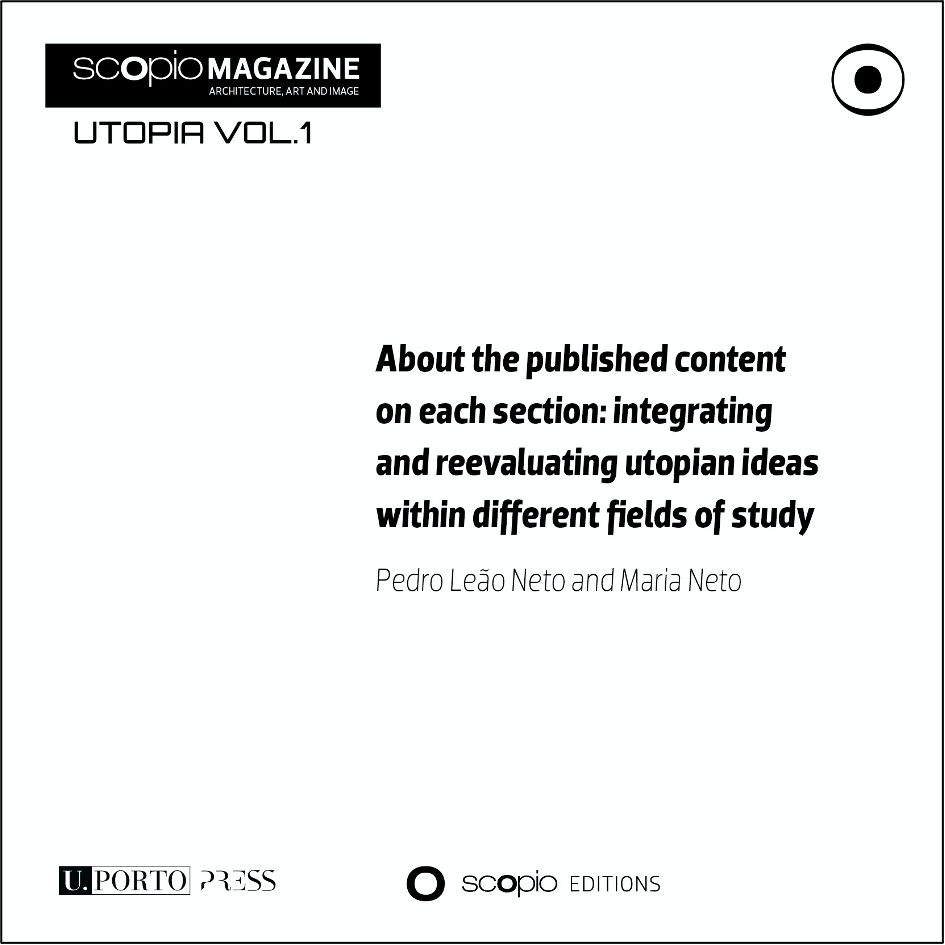
About the published content on each section: Integrating and reevaluating utopian ideas within different fields of study
##plugins.themes.immersion.article.figure##

Abstract
The inaugural theme of scopio Magazine AAI – Vol. 1 centered around Utopia exploring this concept from various angles and perspectives in each section, which involved integrating and reevaluating utopian ideas within different fields of study.
The separate sections in scopio allowed for investigating broader societal concerns, encouraging interdisciplinary discussions across realms such as Architecture, Public Space, Cities, Territories, Technology, Digital Media, Sustainable and Inclusive Environments, and Civic Engagement.
Diving into the ‘Visual Spaces of Change’ section, we encounter James Smith’s “Temporal Dislocation”, a visual essay that masterfully navigates through the complex dialogue between destruction and renewal in our landscapes, both contemporary and historical, and the intricacies of activities evident within constructed environments. The photography series highlights the cyclicality of the natural world after human intervention and is driven by a significant phenomenological intent that bridges the gap between the photographer’s deliberate framing and the casual viewer’s passive encounter with these constructed landscapes. The photograph becomes a subtle language inviting viewers to reevaluate the ostensibly banal and ubiquitous.
In the same section, Lorenzo Iannizzotto presents us with “Urban Wilderness: A Journey through Lisbon Terrain Vague”, a Visual Essay that embraces the fragmentary and uncertain nature of the spaces known as “Terrain Vague” or “Urban Voids”. The author uses photography as a means of urban exploration to gain insight into and describe these areas, and his visual essay depict these spaces in a haphazard and fragmentary manner, respecting in this way their inherent characteristics. In doing so, the work reveals the hidden beauty of those spaces and highlights the substantial potential they hold for the city.
Rafaela Lima’s visual essay, “The Earth from Above: from Below,” in the ‘Image, Space, and Cinematics’ section, looks into the evolution of aerial imagery and its impact on surveillance and cartography. Initially, aerial perspective offered limited insight, but wartime needs and aeronautical advancements soon made it a pivotal reconnaissance and mapping tool. This shift not only enhanced terrain understanding but also spurred innovations in camouflage techniques, notably during World War II, as captured in Harun Farocki’s film “Images of the World and the Inscription of War.” The Pratt Institute of Art further advanced visual strategies by transforming aerial photos into three-dimensional concealment models. Today, advanced technologies enable comprehensive global surveillance, marking a profound transformation in how we visually and conceptually grasp the Earth from above. Lima’s series articulates this dramatic change, reflecting on our relationship with landscapes, from uncharted territories to meticulously surveilled environments.
The ‘Contemporary Archeology’ section presents an intriguing article “Techniques of Discovery: Cryptography and Design” by Roberto Bottazzi, which explores the link between cryptography’s historical methods and modern design practices, particularly in the digital and Machine Learning (ML) realms. He suggests that cryptography’s principles of encoding and decoding offer a conceptual framework for design, enhancing data abstraction and interpretation. Bottazzi draws parallels between historical cryptographic techniques, like Alberti’s and Bacon’s cyphers, and ML’s ability to decipher patterns from extensive datasets, emphasizing the shift in design thinking from form creation to strategic computational tool application. This essay positions ML models as contemporary embodiments of cryptographic logic, framing them as instrumental in navigating design complexities, thus pushing the boundaries of speculative design and innovation.
In the section Landscapes of Care, Inês Osório writes the paper “Sense of Place: How Should We Think About Urban Planning Practices Today?” writes a comprehensive analysis into the evolution of urban planning in response to socio-technological and cultural shifts. The article challenges the architectural hegemony in urban space creation and urges reconsidering diverse spatial practices. Proposing a collision path between architecture and contemporary art, it views this nexus as crucial to redefining public space and urban territory. The paper advocates for a Bauhausian approach, integrating architecture, art, and design as a symbiotic urban design triad to foster a pluralistic dialogue and reimagine urban landscapes. The author suggests transcending conventional methodologies and encouraging an artistic contribution to urban regeneration, thereby enriching the experiential quality of urban environments.
(...)
Most read articles by the same author(s)
- Pedro Leão Neto, About the jury’s evaluation , SCOPIO MAGAZINE ARCHITECTURE, ART AND IMAGE: Vol. 1 No. 1 (2023): scopio Magazine AAI-Utopia
- Pedro Leão Neto, José Carneiro, Visual Essays on Urbanity: A Photographic Journey through Architectural Transformations , SCOPIO MAGAZINE ARCHITECTURE, ART AND IMAGE: Vol. 1 No. 1 (2023): scopio Magazine AAI-Utopia
- Pedro Leão Neto, Towards a collaborative notion of Utopia , SCOPIO MAGAZINE ARCHITECTURE, ART AND IMAGE: Vol. 1 No. 1 (2023): scopio Magazine AAI-Utopia
- Pedro Leão Neto, Maria Neto, José Carneiro, Next Edition and Scopio & Contrast International Conference , SCOPIO MAGAZINE ARCHITECTURE, ART AND IMAGE: Vol. 1 No. 1 (2023): scopio Magazine AAI-Utopia
- Pedro Leão Neto, Fátima Vieira, Drawing and Photography International Contest (DPIc) - Next Edition , SCOPIO MAGAZINE ARCHITECTURE, ART AND IMAGE: Vol. 1 No. 1 (2023): scopio Magazine AAI-Utopia
- Ana Miriam Rebelo, Maria Neto, Pedro Leão Neto, About the Published Content on Each Section | Exploring Contemporary Realities , SCOPIO MAGAZINE ARCHITECTURE, ART AND IMAGE: Vol. 2 No. 1 (2024): scopio Magazine AAI-Exploring Contemporary Realities
- Ana Miriam Rebelo, Maria Neto, Pedro Leão Neto, About the jury’s evaluation , SCOPIO MAGAZINE ARCHITECTURE, ART AND IMAGE: Vol. 2 No. 1 (2024): scopio Magazine AAI-Exploring Contemporary Realities
